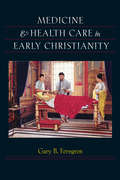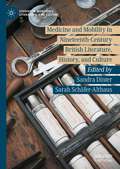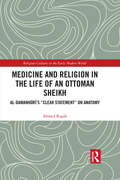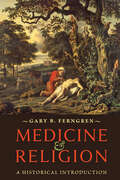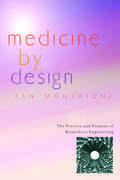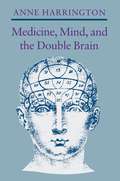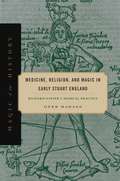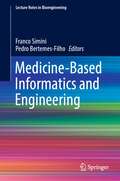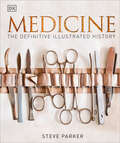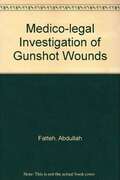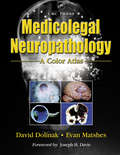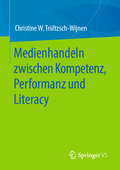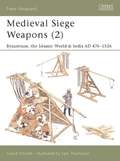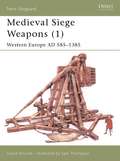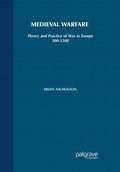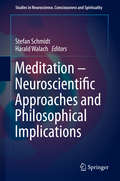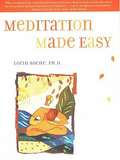- Table View
- List View
Medicine and Health Care in Early Christianity
by Gary B. FerngrenDrawing on New Testament studies and recent scholarship on the expansion of the Christian church, Gary B. Ferngren presents a comprehensive historical account of medicine and medical philanthropy in the first five centuries of the Christian era.Ferngren first describes how early Christians understood disease. He examines the relationship of early Christian medicine to the natural and supernatural modes of healing found in the Bible. Despite biblical accounts of demonic possession and miraculous healing, Ferngren argues that early Christians generally accepted naturalistic assumptions about disease and cared for the sick with medical knowledge gleaned from the Greeks and Romans.Ferngren also explores the origins of medical philanthropy in the early Christian church. Rather than viewing illness as punishment for sins, early Christians believed that the sick deserved both medical assistance and compassion. Even as they were being persecuted, Christians cared for the sick within and outside of their community. Their long experience in medical charity led to the creation of the first hospitals, a singular Christian contribution to health care.
Medicine and Mobility in Nineteenth-Century British Literature, History, and Culture (Studies in Mobilities, Literature, and Culture)
by Sandra Dinter Sarah Schäfer-AlthausMedicine and Mobility in Nineteenth-Century British Literature, History, and Culture analyses the cultural and literary histories of medicine and mobility as entangled processes whose discourses and practices constituted, influenced, and transformed each other. Presenting case studies of novels, poetry, travel narratives, diaries, ship magazines, skin care manuals, asylum records, press reports, and various other sources, its chapters identify and discuss diverse literary, historical, and cultural texts, contexts, and modes in which medicine and mobility intersected in nineteenth-century Britain, its empire, and beyond, whereby they illustrate how the paradigms of mobility studies and the medical humanities can complement each other.
Medicine and Religion in the Life of an Ottoman Sheikh: Al-Damanhuri’s "Clear Statement" on Anatomy (Religious Cultures in the Early Modern World)
by Ahmed RagabIn 1768, Aḥmad al-Damanhūrī became the rector (shaykh) of al-Azhar, which was one of the most authoritative and respected positions in the Ottoman Empire. He occupied this position until his death. Despite being a prolific author, whose writings are largely extant, al-Damanhūrī remains almost unknown, and much of his work awaits study and analysis. This book aims to shed light on al-Damanhūrī’s diverse intellectual background, and that of and his contemporaries, building on and continuing the scholarship on the academic thought of the late Ottoman Empire. The book specifically investigates the intersection of medical and religious knowledge in Eighteenth-Century Egypt. It takes as its focus a manuscript on anatomy by al-Damanhūrī (d. 1778), entitled "The Clear Statement on the Science of Anatomy (al-qawl al-ṣarīḥ fī ʿilm al-tashrīḥ),". The book includes an edited translation of The Clear Statement, which is a well-known but unstudied and unpublished manuscript. It also provides a summary translation and analysis of al-Damanhūrī’s own intellectual autobiography. As such, the book provides an important window into a period that remains deeply understudied and a topic that continues to cause debates and controversies. This study, therefore, will be of keen interest to scholars working on the "post-Classical" Islamic world, as well as historians of religion, science, and medicine looking beyond Europe in the Early Modern period.
Medicine and Religion: A Historical Introduction
by Gary B. FerngrenExplores the interplay of medicine and religion in Western societies.Medicine and Religion is the first book to comprehensively examine the relationship between medicine and religion in the Western tradition from ancient times to the modern era. Beginning with the earliest attempts to heal the body and account for the meaning of illness in the ancient Near East, historian Gary B. Ferngren describes how the polytheistic religions of ancient Mesopotamia, Egypt, Greece, and Rome and the monotheistic faiths of Judaism, Christianity, and Islam have complemented medicine in the ancient, medieval, and modern periods.Ferngren paints a broad and detailed portrait of how humans throughout the ages have drawn on specific values of diverse religious traditions in caring for the body. Religious perspectives have informed both the treatment of disease and the provision of health care. And, while tensions have sometimes existed, relations between medicine and religion have often been cooperative and mutually beneficial. Religious beliefs provided a framework for explaining disease and suffering that was larger than medicine alone could offer. These beliefs furnished a theological basis for a compassionate care of the sick that led to the creation of the hospital and a long tradition of charitable medicine.Praise for Medicine and Health Care in Early Christianity, by Gary B. Ferngren"This fine work looks forward as well as backward; it invites fuller reflection of the many senses in which medicine and religion intersect and merits wide readership."—JAMA"An important book, for students of Christian theology who understand health and healing to be topics of theological interest, and for health care practitioners who seek a historical perspective on the development of the ethos of their vocation."—Journal of Religion and Health
Medicine and the Body in Early Modern Europe (Palgrave Studies in Medieval and Early Modern Medicine)
by Michael StolbergThis volume brings together essays on a wide range of topics, from the popular notion of &‘climacterical&’ years believed to recur every seventh year, and the origins and development of the concept of &‘palliative&’ care in premodern medicine, to the early modern understanding of &‘melancholia&’ as a disease rather than just a temperament, and its visual representation in the famous &‘Melancholia&’ paintings of Lukas Cranach the Elder. It examines the casuistic training, empirical observations, and public self-fashioning of learned physicians, and explores major concepts of early modern medical theory, such as &‘innate heat&’ and diseases of the &‘total substance&’ as presented and elaborated in Avicenna's &‘Canon medicinae and in Daniel Sennert's atomistic interpretation of body and soul. Published for the first time in an English translation, these essays offer readers many illuminating insights into the fascinating world of early modern medicine.
Medicine and the Saints: Science, Islam, and the Colonial Encounter in Morocco, 1877-1956.
by Ellen J. AmsterThe colonial encounter between France and Morocco took place not only in the political realm but also in the realm of medicine. Because the body politic and the physical body are intimately linked, French efforts to colonize Morocco took place in and through the body. Starting from this original premise, Medicine and the Saints traces a history of colonial embodiment in Morocco through a series of medical encounters between the Islamic sultanate of Morocco and the Republic of France from 1877 to 1956. Drawing on a wealth of primary sources in both French and Arabic, Ellen Amster investigates the positivist ambitions of French colonial doctors, sociologists, philologists, and historians; the social history of the encounters and transformations occasioned by French medical interventions; and the ways in which Moroccan nationalists ultimately appropriated a French model of modernity to invent the independent nation-state. Each chapter of the book addresses a different problem in the history of medicine: international espionage and a doctor’s murder; disease and revolt in Moroccan cities; a battle for authority between doctors and Muslim midwives; and the search for national identity in the welfare state. This research reveals how Moroccans ingested and digested French science and used it to create a nationalist movement and Islamist politics, and to understand disease and health. In the colonial encounter, the Muslim body became a seat of subjectivity, the place from which individuals contested and redefined the political.
Medicine by Design: The Practice and Promise of Biomedical Engineering
by Fen MontaigneA heart that once beat erratically has regained its natural rhythm. A woman paralyzed by an automobile accident is now able to resume her favorite hobby. Physicians using a robotic surgeon named da Vinci perform lifesaving operations. These are some of the feats of biomedical engineering, one of the fastest-moving areas in medicine. In this exhilarating book, award-winning writer Fen Montaigne journeys through this little-known world, sharing the stories of ordinary people who have been transformed by technology. From the almost commonplace pacemaker to the latest generation of artificial hearts, Montaigne tells the stories of pioneering patients, engineers, and surgeons. Taking the reader behind the scenes of a dozen of America's leading centers of biomedical engineering, Montaigne recounts the field's history while describing cutting-edge work in medical imaging, orthopedics, cardiovascular care, neurological therapies, and genetics. Through the stories of patients whose lives have been saved and improved by biomedical devices, Montaigne reveals the marriage of medicine and engineering to be one of society's greatest advances.
Medicine, Mind, and the Double Brain: A Study in Nineteenth-Century Thought
by Anne HarringtonThe description for this book, Medicine, Mind, and the Double Brain: A Study in Nineteenth-Century Thought, will be forthcoming.
Medicine, Religion, and Magic in Early Stuart England: Richard Napier's Medical Practice (Magic in History)
by Ofer HadassThe astrologer-physician Richard Napier (1559-1634) was not only a man of practical science and medicine but also a master of occult arts and a devout parish rector who purportedly held conversations with angels. This new interpretation of Napier reveals him to be a coherent and methodical man whose burning desire for certain, true knowledge contributed to the contemporary venture of putting existing knowledge to useful ends.Originally trained in theology and ordained as an Anglican priest, Napier later studied astrological medicine and combined astrology, religious thought, and image and ritual magic in his medical work. Ofer Hadass draws on a remarkable archive of Napier’s medical cases and religious writings—including the interviews he claimed to have held with angels—to show how Napier’s seemingly inconsistent approaches were rooted in an inclusive and coherent worldview, combining equal respect for ancient authority and for experientially derived knowledge. Napier’s endeavors exemplify the fruitful relationship between religion and science that offered a well-founded alternative to the rising mechanistic explanation of nature at the time.Carefully researched and compellingly told, Medicine, Religion, and Magic in Early Stuart England is an insightful exploration of one of the most fascinating figures at the intersection of medicine, magic, and theology in early modern England and of the healing methods employed by physicians of the era.
Medicine, Religion, and Magic in Early Stuart England: Richard Napier's Medical Practice (Magic in History)
by Ofer HadassThe astrologer-physician Richard Napier (1559-1634) was not only a man of practical science and medicine but also a master of occult arts and a devout parish rector who purportedly held conversations with angels. This new interpretation of Napier reveals him to be a coherent and methodical man whose burning desire for certain, true knowledge contributed to the contemporary venture of putting existing knowledge to useful ends.Originally trained in theology and ordained as an Anglican priest, Napier later studied astrological medicine and combined astrology, religious thought, and image and ritual magic in his medical work. Ofer Hadass draws on a remarkable archive of Napier’s medical cases and religious writings—including the interviews he claimed to have held with angels—to show how Napier’s seemingly inconsistent approaches were rooted in an inclusive and coherent worldview, combining equal respect for ancient authority and for experientially derived knowledge. Napier’s endeavors exemplify the fruitful relationship between religion and science that offered a well-founded alternative to the rising mechanistic explanation of nature at the time.Carefully researched and compellingly told, Medicine, Religion, and Magic in Early Stuart England is an insightful exploration of one of the most fascinating figures at the intersection of medicine, magic, and theology in early modern England and of the healing methods employed by physicians of the era.
Medicine-Based Informatics and Engineering (Lecture Notes in Bioengineering)
by Franco Simini Pedro Bertemes-FilhoThis book originates from the idea to adapt biomedical engineering and medical informatics to current clinical needs and proposes a paradigm shift in medical engineering, where the limitations of technology should no longer be the starting point of design, but rather the development of biomedical devices, software, and systems should stem from clinical needs and wishes. Gathering chapters written by authoritative researchers, working the interface between medicine and engineering, this book presents successful attempts of conceiving technology based on clinical practice. It reports on new strategies for medical diagnosis, rehabilitation, and eHealth, focusing on solutions to foster better quality of life through technology, with an emphasis on patients’ and clinical needs, and vulnerable populations. All in all, the book offers a reference guide and a source of inspiration for biomedical engineers, clinical scientists, physicians, and computer scientists. Yet, it also includes practical information for personnel using biomedical equipment, as well as timely insights that are expected to help health agencies and software firms in their decision-making processes.
Medicine: The Definitive Illustrated History (DK Definitive Visual Histories)
by DKSee the greatest medical breakthroughs come to life through superb illustrations!From ancient herbal medicine to traditional Chinese medicine, take a visual tour throughout the history of medicine with this comprehensive medical reference book.Discover medicine through time! Here&’s what you&’ll find in this illustrated history book about medicine: • Offers a broad and accessible visual history of medicine — from the first herbal remedies to efforts surrounding the COVID-19 pandemic • Intriguing narratives are illustrated with photographs, paintings and artifacts • Offers a vivid, compelling and informative read written in an engaging and colourful style • Excerpts from documents, diaries and notebooks offer fascinating eyewitness accounts This medicine history book charts fascinating developments in diagnosis, surgery, healing and drugs through the ages. Feature spreads explore key medical concepts in detail and enhance the reader&’s understanding of human anatomy, surgical instruments and medical developments. Clear diagrams explain major diseases like cancer, and trace the progression of medical treatment through time, from ancient healing arts to scurvy and smallpox to modern psychiatry. Double-page features tell the story of the men and women involved in the extraordinary evolutions of this scientific field — from Hippocrates to Florence Nightingale.It's the perfect book for medical professionals, students of medicine or anyone with a keen interest in medicine, science or social history.
Medico-Legal Issues in Infectious Diseases
by I. W. FongThe aim of this book is not to encourage defensive medical practice, but to help provide better, optimum care to patients and to be forth right and honest to our dear customers about our inevitable mistakes. This book will focus on clinical issues facing physicians in different settings (which can lead to malpractice), and the best approach to use to avoid litigations, and practice good medicine.
Medicolegal Investigation of Gunshot Wounds
by Adbullah FattehWas written by an expert who at the time was a D.M.E. a visiting professor of Pathology and a consultant to the Criminal Justice Institute at Fort Lauderdale, Florida. Clearly written and easily understood, the book deals with all aspects of medicolegal investigation of gunshot wounds and deaths.The duties and responsibilities of the medical investigators and the police are explicitly outlined and guidelines are established for co-operative efforts between the two. The investigation of homicides, suicides, and accidents involving firearms, including investigation of the scene of the injury or death.
Medicolegal Issues for Diagnostic Imaging Professionals
by Colin M. Howles Zeev Shoham Robert J. Parelli David. K WeissmanThe constant advances in diagnostic imaging have had an impact on the practice, attitudes, and moral values of all who participate in health care. Now in its fourth edition, the original Medicolegal Issues for Radiographers has been updated and retitled, broadening the scope of content to include issues essential to all diagnostic imaging pr
Medicolegal Neuropathology: A Color Atlas
by Evan W. Matshes David DolinakWith nearly 600 autopsy photographs, this atlas shows various trauma and diseases of the brain and spinal cord in the forensic context of sudden death investigation. It also provides a simple, straight forward, concise text organized in a primarily case-oriented format. Unlike most other neuropathology texts, attention is given to skull fractures and scalp injuries. Where necessary, radiologic and microscopic images have also been included to facilitate learning along with a brief general anatomy of the brain and spinal cord. Thus pathologists who are not specialized in neuropathology can compare a variety of autopsy findings with cases illustrated in the text.
Medienbildung im Medienhandeln: Rekonstruktionen am Beispiel von Instant-Messaging-Gruppen in Schulklassen (Digitale Kultur und Kommunikation #11)
by Caroline GrabensteinerWie entfaltet sich Bildung angesichts der Handlungsmöglichkeiten in digitalen Medien? In dieser Grounded-Theory Studie werden Fragen zu Medienbildung und Medienhandeln verknüpft. Das Phänomen Instant-Messaging-Gruppen in Schulklassen steht im Zentrum der Analyse. Ergebnis ist ein Theoriemodell zur Rekonstruktion der Herstellung von Selbst- und Weltrelationen auf materialer, sozialer und biografischer Ebene im Prozess der Konstruktion von Handlungskontexten, Themen und sozialen Praktiken der Medienkommunikation mit dem Potenzial zur Erweiterung auf andere Soziale Medien.
Medienhandeln zwischen Kompetenz, Performanz und Literacy
by Christine W. Trültzsch-WijnenDas Buch diskutiert die soziale und individuelle Bedingtheit von Medienkompetenz. Im Mittelpunkt steht die Frage, wie sich das Medienhandeln von Individuen im Hinblick auf deren Medienkompetenz, im Sinne eines sicheren und selbstbestimmten Handelns im Umgang mit Medien, erklären und beurteilen lässt. Dies setzt eine Betrachtung des Medienhandelns vor dem Hintergrund der Beziehungen zwischen der Kompetenz zu Handeln, als Summe von Fähigkeiten, Fertigkeiten und Wissen sowie der kognitiven Beherrschung von Regeln des Verhaltens (moralische Regeln, rechtliche Regeln sowie Regeln der Klugheit), und der Performanz, als tatsächliches Handeln eines Individuums, voraus. Dabei wird auf theoretischer Ebene der Frage nach der sozialen Determinierung eines selbstbestimmten Handelns im Umgang mit Medien einschließlich dafür erforderlicher Fähigkeiten, Fertigkeiten sowie des damit verbundenen Wissens nachgegangen. Außerdem wird das Verhältnis des deutschsprachigen Medienkompetenzdiskurses zum internationalen Diskurs über media literacy erläutert. Es werden Gemeinsamkeiten und Unterschiede herausgearbeitet und Potentiale für eine gegenseitige Befruchtung beider Perspektiven aufgezeigt. Darüber hinaus wird die empirische Relevanz und Anwendbarkeit dieser theoretischen Überlegungen anhand zweier Studien illustriert.
Medieval Arms and Armor: A Pictorial Archive
by J. H. Hefner-AlteneckA renowned 19th-century cultural historian and specialist on the Middle Ages, J. H. Hefner-Alteneck spent much of his life observing the influence of art on many aspects of human life, including weaponry. His illustrations for this handsome archive — drawn with incredible exactitude — depict a wide array of medieval weapons and armor dating from the early ninth century to the mid-1700s.Adapted primarily from decorative ornamentation on burial monuments and manuscripts, hundreds of finely executed images depict authentic shields, swords, crossbows, helmets, and highly ornate suits of body armor for knights and their steeds. Newly translated descriptive notes, extracted from the original German text, identify the subjects. First published more than 100 years ago, this meticulously rendered study remains an invaluable source of permission-free illustrations for artists and designers and an indispensable reference for scholars, collectors, and hobbyists.
Medieval Science
by David C. Lindberg Michael H. ShankThis volume in the highly respected Cambridge History of Science series is devoted to the history of science in the Middle Ages from the North Atlantic to the Indus Valley. Medieval science was once universally dismissed as non-existent - and sometimes it still is. This volume reveals the diversity of goals, contexts and accomplishments in the study of nature during the Middle Ages. Organized by topic and culture, its essays by distinguished scholars offer the most comprehensive and up-to-date history of medieval science currently available. Intended to provide a balanced and inclusive treatment of the medieval world, contributors consider scientific learning and advancement in the cultures associated with the Arabic, Greek, Latin and Hebrew languages. Scientists, historians and other curious readers will all gain a new appreciation for the study of nature during an era that is often misunderstood.
Medieval Siege Weapons: Byzantium, the Islamic World & India AD 476-1526
by David NicolleDuring medieval era, the pre-existing military-technological traditions from the ancient worlds were brought together. Three civilizations were primarily responsible for this evolution: the Late-Roman or Byzantine Empire, the Islamic World, and latterly the Mongol 'World Empire'. This book examines the resulting stone-throwing machines from torsion 'energy storage' systems, to manpowered and counterbalance sling devices, rockets and others.
Medieval Siege Weapons: Western Europe AD 585-1385
by David NicolleThis text explores a range of devices and details the changes in medieval siege warfare brought about by the mixing of traditions from Greece, Rome, Persia, India and China.
Medieval Warfare: Theory and Practice of War in Europe 300–1500
by Helen NicholsonWarfare in medieval times was never static or predictable - although there were ideals and conventions to follow, in the field commanders had to use their initiative and adapt to the needs of the moment. In this concise, wide-ranging study, Helen Nicholson provides the essential introductory guide to a fascinating subject. Medieval Warfare - surveys and summarises current debates and modern research into warfare throughout the whole of the medieval period across Europe - sets medieval warfare theory and practice firmly into context as a continuation and adaptation of practice under the Roman Empire, tracing its change and development across more than a millennium - considers military personnel, buildings and equipment, as well as the practice of warfare by land and sea
Meditation - Neuroscientific Approaches and Philosophical Implications
by Harald Walach Stefan SchmidtThis volume features a collection of essays on consciousness, which has become one of the hot topics at the crossroads between neuroscience, philosophy, and religious studies. Is consciousness something the brain produces? How can we study it? Is there just one type of consciousness or are there different states that can be discriminated? Are so called "higher states of consciousness" that some people report during meditation pointing towards a new understanding of consciousness? Meditation research is a new discipline that shows new inroads into the study of consciousness. If a meditative practice changes brain structure itself this is direct proof of the causal influence of consciousness onto its substrate. If different states of consciousness can be linked with properties and states of the brain this can be used to study consciousness more directly. If the sense of self is modifiable through meditative techniques and this can be objectively shown through neuro-imaging, this has profound implications for our understanding of who we are. Can consciousness, in deep states of meditative absorption, actually access some aspect of reality which we normally don't? Meditation research can potentially foster us with a new access to the phenomenological method in general. This has even been branded with a new catch-phrase: Contemplative Science. It brings together the most modern neuroscientific approach and the most advanced phenomenological methodology of studying the mind from within, through highly skilled self-observation that has gone through many thousand hours of honing the capacity to look carefully, without distraction. This book addresses these issues by bringing together some of the leading researchers and thinkers in the field. The scope of the volume reaches from first person neuroscience to Indian philosophy, from pedagogic applications to epistemological aspects and from compassion meditation to the study of brain activity.
Meditation Made Easy
by Camille Maurine Lorin RocheTips on how to make meditation simple and pleasurable. Provides info on creating mini meditations, overcoming boredom and racing thoughts, customizing personal practices, and more.
